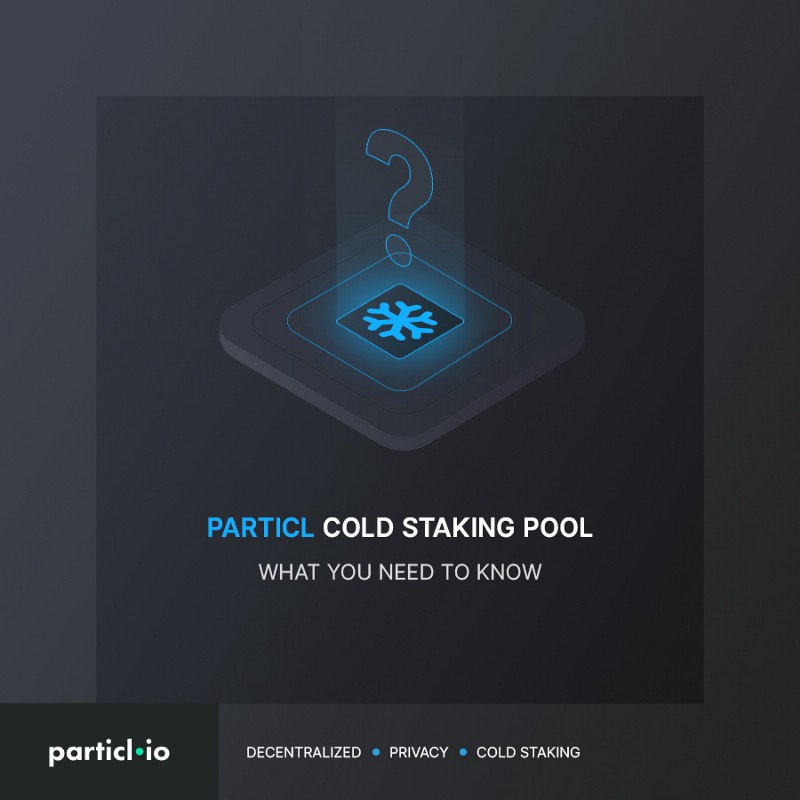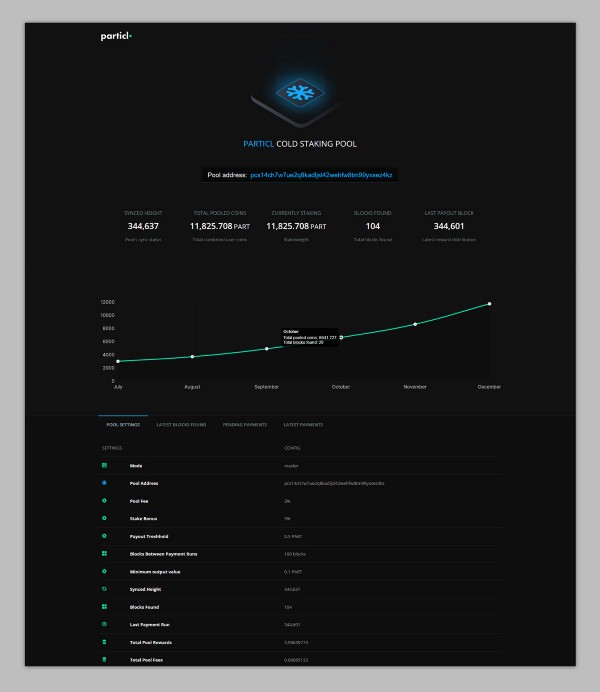
Cold staking pools have been an item the community has been requesting for quite some time, and they are now available for anyone to use. In fact, discussions about it go as far back as January 2018 when a bounty was eventually set up for the coding of a cold staking pool. Tecnovert, Lead Core Developer & Cryptographer, Gerlof, Lead Designer and Branding, and Kewde, Core Developer, have instead taken the initiative of going ahead and work the code so that we could all use and easily set up cold staking pools.
These cold staking pools are going to make staking on Particl easier than ever and accessible to everyone, allowing you to earn passive income regardless of the number of coins you hold or your technical skills.
Cold Staking Pool Interface Released! - Crypto Guard - Medium
Today is the day we release the long-awaited cold staking pool user interface! While these pools have now been…particl.news
- Tecnovert’s pool (mainnet): http://66.172.10.231:903/
- Tecnovert’s pool (testnet): http://66.172.10.231:902/
- CryptoAcademie’s pool: http://167.179.93.172/
- Particl.page’s pool: https://pool.particl.page
What Are Cold Staking Pools
Staking Pools
Staking pools are to Proof-of-Stake coins what mining pools are to Proof-of-Work coins (i.e. Bitcoin).
In the context of cryptocurrency mining, a mining pool is the pooling of resources by miners, who share their processing power over a network, to split the reward equally, according to the amount of work they contributed to the probability of finding a block. — Wikipedia
In fact, staking pools allow you to “team up” with other stakers and combine your staking powers in order to earn more frequent staking rewards. All rewards earned while staking from a pool are sent over to the pool operator, which then executes payouts proportional to how much you’ve contributed to the total amount of rewards the pool earned. This is particularly useful if you own fewer coins and still want to stake your coins as it means you’ll earn more frequent, but smaller, staking rewards.
Cold Staking Pools
tecnovert/particl-coldstakepool
Pooled coldstaking demo. Contribute to tecnovert/particl-coldstakepool development by creating an account on GitHub.github.com
The reason Particl’s staking pools are called cold staking pools is that they operate in the same way cold staking does. Cold staking allows you to delegate your staking powers to a cold staking node which can then stake on your behalf, but without being able to spend your coins. In other words, cold staking allows you to stake coins stored offline without giving the node operator access to your coins (usually, the operator is the same user as the coins being staked, although not obligatory).
In that sense, cold staking pools are like special cold staking nodes that allows the pool operator to spend staking rewards on your behalf, but not your coins. This distinction between staking pools and cold staking pools is important because the latter is much more secure. Because the pool doesn’t actually hold any coin other than a few hours worth of staking rewards, there is actually very little to steal for a hacker as the entirety of the staking weight possessed by the cold staking pool isn’t even in their possession. Cold staking pools keep you in full control of your own funds at all time!
Note: You can get the full benefits of the world’s most secure Proof-of-Stake protocol by combining cold staking or cold staking pools to the security of a Ledger Nano S hardware device. This will make your funds impossible to steal even when unlocking your wallet from an infected or compromised computer. To learn more about this, read the “The Ultimate Vulnerability” section of this blog post. To learn how to connect your funds stored on a Ledger Nano S hardware device to a staking pool, follow the instructions in this tutorial and, instead of using a cold staking node public key, use the public key given to you by the cold staking pool.
How Are Cold Staking Pools Going to Benefit the Particl Network?
In short, it’s going to make staking much more accessible and practical to everyone, regardless of the number of coins you hold or your level of expertise.

Staking With Fewer Coins
In fact, staking with only a small PART balance is not ideal because of the size of each staking reward (~1.25 PART at the time of this writing). To put that in perspective, consider the moment 1 PART was worth around $50. If you wanted to buy $1,000 worth of Particl, that would have given you around 20 PART. Back then, the staking interest rate was 5%. This meant that, after one full year of staking, you would have earned around 1 PART staking on the network, a yearly reward that is smaller than the payout size. In other words, chances are high that you wouldn’t even have received a single reward during the entire year even though you helped secure the network the whole time. This phenomenon is not unlike “solo mining” with a poor GPU on Proof-of-Work networks.
Now, with cold staking pools, you could “team up” with the other stakers connected to the same pool as you and get a share of the staking rewards earned by the pool proportional to how much you’ve contributed to it. Instead of waiting a long time to receive one large staking reward, you would receive smaller but more frequent rewards. This makes staking much more interesting and interactive, and also makes staking with fewer coins more stable and reliable.
Easier to Set Up for Non-Technical Users
Another obstacle to cold staking is the technical level required to set up a cold staking node. Although not overly complicated, especially when following the cold staking node setup tutorial, it does require time and effort to correctly execute. It also generally requires the use of a staking device like a Raspberry Pi or a VPS server, all of which adds up to the difficulty and hassle of setting cold staking up.
On top of that, staking devices need to be maintained quite regularly: you need to make sure it is up 24/7, you need to ideally keep it updated to the latest Particl Core version (especially when there are hardforks), and you need to make sure it is properly restarted when, for example, there is a power outage or something that makes the electricity go off.
For a lot of users, especially the less technical ones, the dedication it takes to set cold staking up and maintain its device is simply too much. Cold staking pools, on the other hand, do not require you to prepare and manage a staking node since that part is taken care of by the pool operator. Enabling cold staking has never been as easy as with cold staking pools, and it shouldn’t take more than 2 minutes off of your time!
More Coins Being Staked
Because of how much it would benefit some types of users, cold staking pools are likely to encourage more people to stake their coins. This will benefit the network by having fewer available coins on the markets, meaning it would be much harder for an attacker to acquire large sums of PART coins and try to damage the network with a 51% attack. In Proof-of-Stake networks, more coins being put up for staking means it is more secure.
Note: Staking pools do present a risk to the network if misused. In fact, while they make 51% attacks harder to execute by reducing the number of coins available on the markets, they could also potentially end up staking 51% of the total network supply if users are not careful enough. As such, we encourage as many people within the community to come up with their own cold staking pools (the source code is openly available here) in order to create many different options for users which would lead to a better decentralization of the staking supply.
Quick Facts
- You can still vote on Community Proposals and flag listings while your funds are connected to a cold staking pool.
- The pool operator cannot vote on your behalf, nor can he flag listings using your coin weight.
- Records can be obtained to verify the pool’s operator integrity.
- Payout threshold (the total amount of PART you need to accumulate within the pool before a payout is executed) is set up by the pool operator and can be changed at any time.
- In the future, pools might be able to read specially formatted control transactions, meaning smart-contracts could potentially interact with them.
- In the future, research might be done to integrate the Lightning Network to cold staking pools, which would allow an almost infinite number of micro-payouts per day (i.e. multiple payouts throughout the day of 0.01 PART). This may or may not happen depending on the need and feasibility of such a feature.
Get Started Today!
Connect to a staking pool today and start reaping its benefits in less than 2 minutes! Just follow this quick and easy tutorial and lay back while your PART stack keeps increasing!
coldstakingpool_connect * Particl Project Wiki
In fact, cold staking pools allow you to "team up" with other stakers and combine your staking powers in order to earn…particl.wiki
Want to create a cold staking pool of your own? Just follow these simple instructions (Linux knowledge required):
coldstakingpool_create * Particl Project Wiki
As per the open-source nature of Particl cold staking pools, anyone can easily set up and manage their own pool. You…particl.wiki
Disclaimer
The Particl team is not responsible for the management, user support, and debugging of any pool. While we will offer support for the cold staking pool code itself, we won’t be offering support for any of its implementation made by third-parties; this responsibility should lie within the pool operator himself.